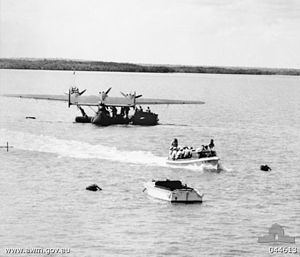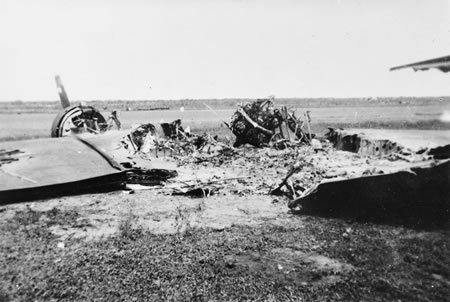22 aircraft 10 aircraft Result Japanese victory | Date 3 March 1942 | |
 | ||
88 killed (official toll)22 aircraft destroyed 1 killed (official toll)2 aircraft destroyed Similar World War II, Pacific War, Battle of Ambon, Battle of Balikpapan, Battle of Java | ||
The town of Broome, Western Australia was attacked by Japanese fighter planes on 3 March 1942, during World War II. At least 88 people were killed.
Contents

Although Broome was a small pearling port at the time, it was also a refuelling point for aircraft, on the route between the Netherlands East Indies and major Australian cities. As a result, Broome was on a line of flight for Dutch and other refugees, following the Japanese invasion of Java, and had become a significant Allied military base. During a two-week period in February–March 1942, more than a thousand refugees from the Dutch East Indies—many of them in flying boats, which often served as airliners at the time—passed through Broome.
The number of refugees has previously been given as 8,000, but new research by Dr Tom Lewis contends that this figure is massively overstated. The figure was first quoted in the relevant Australian Official War History and has been reproduced in many publications since. The actual number of aerial evacuees passing through Broome at this time is estimated to have been only 1,350. Most of these were military personnel. There were approximately just 250 Dutch civilian refugees, most of whom were family members of Dutch aircrews.
The attack
Lt Zenjiro Miyano—the commander of Dai 3 Kohkuu Sentai (3rd Air Group) of the Imperial Japanese Navy Air Service—led nine Mitsubishi A6M2 Zero fighters and a Mitsubishi C5M2 reconnaissance plane from their base at Kupang, Timor in the attack, on the morning of 3 March.
From about 09:20, the Zeros made strafing attacks on the flying boat anchorage at Roebuck Bay and the Royal Australian Air Force (RAAF) base at Broome Airfield. No bombs were dropped, although some were reported, perhaps a result of witnesses seeing the Zero pilots releasing their drop tanks. The raid lasted an hour.
The Japanese fighters destroyed at least 22 Allied aircraft. These included an airborne United States Army Air Forces (USAAF) B-24A Liberator, full of wounded personnel—more than 30 died when it crashed in the sea, about 16 km (8.6 nmi; 9.9 mi) off Broome. The Allies also lost 15 flying boats at anchorage; many Dutch refugees were on board and the exact number and identities of all those killed is unknown but the ages and names of some were recorded when they were moved from Broome to the Perth War Cemetery at Karrakatta in 1950 (the known casualties include 9 children, the youngest being just 1). At the airfield, the Japanese fighters destroyed two B-17E Flying Fortresses and a B-24 belonging to the USAAF, two Lockheed Hudsons belonging to the RAAF and a Lockheed Lodestar belonging to the Royal Netherlands East Indies Air Force (ML-KNIL).
The aircraft destroyed included: eight Catalinas belonging to the Royal Netherlands Navy Air Service (MLD), United States Navy and the Royal Air Force; two Short Empires belonging to the RAAF and QANTAS, and five Dornier Do 24s belonging to the MLD.
A KLM Douglas DC-3 airliner—PK-AFV (carrying refugees from Bandung)—was also shot down, 80 km (50 mi) north of Broome, with the loss of four lives and diamonds worth £150,000 – 300,000 (now approximately A$20–40 million).
There were no Allied fighter planes based in Broome at the time. The Zeroes encountered some light arms fire from the ground. One Zero pilot—Warrant Officer Osamu Kudō—was killed by ground fire from a Dutch ML-KNIL pilot, First Lieutenant Gus Winckel, using a 7.9mm machine gun he had removed from his Lodestar. Winckel balanced the weapon on his shoulder, and sustained burns to his left forearm, when it touched the barrel of the gun after firing. Another Zero ran out of fuel and ditched while returning to his base, although the pilot survived.
In 2010, new research argued instead that Kudo’s Zero was shot down by the tail guns in the B-24A Arabian Nights, which itself was downed by Kudo's attack with the loss of 19 of the 20 American military personnel on board.
Aftermath
Following the attack, an RAAF officer—Pilot Officer Frank Russell, who had been on one of the flying boats during the raid—wrote of
Charlie D'Antoine—an Aboriginal flying boat refueller—helped two passengers from the planes to reach the shore, swimming through burning fuel and wreckage. D'Antoine later received a bravery award from the Dutch government and was invited to attend a royal reception in the Netherlands.
At least one U.S. serviceman—Sgt. Melvin Donoho—managed to swim about 16 km (9.9 mi) from the crashed B-24 to shore, a journey which took him more than 36 hours. Some accounts say that a Sgt. Willard J. Beatty also made it ashore but died soon afterwards; other sources suggest that this was a false report, emanating from one newspaper article.
Japanese aircraft later made several smaller attacks on the Broome area. On 20 March, Mitsubishi G4M2 "Betty" medium bombers made a high-altitude attack on the airfield. One civilian was killed and there was some crater damage. The last attack was in August 1943.
Postscript
The Australian journalist, broadcaster and author Coralie Clarke Rees (1908–1972) published a less prosaic, and highly personal account of the Broome air raid in her 1946 elegy to her dead airman brother, Silent His Wings:
